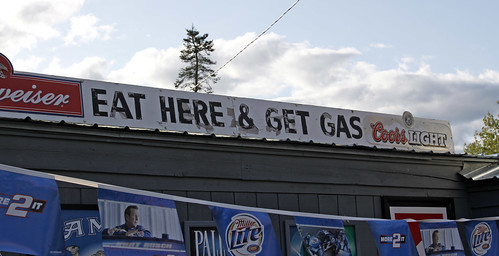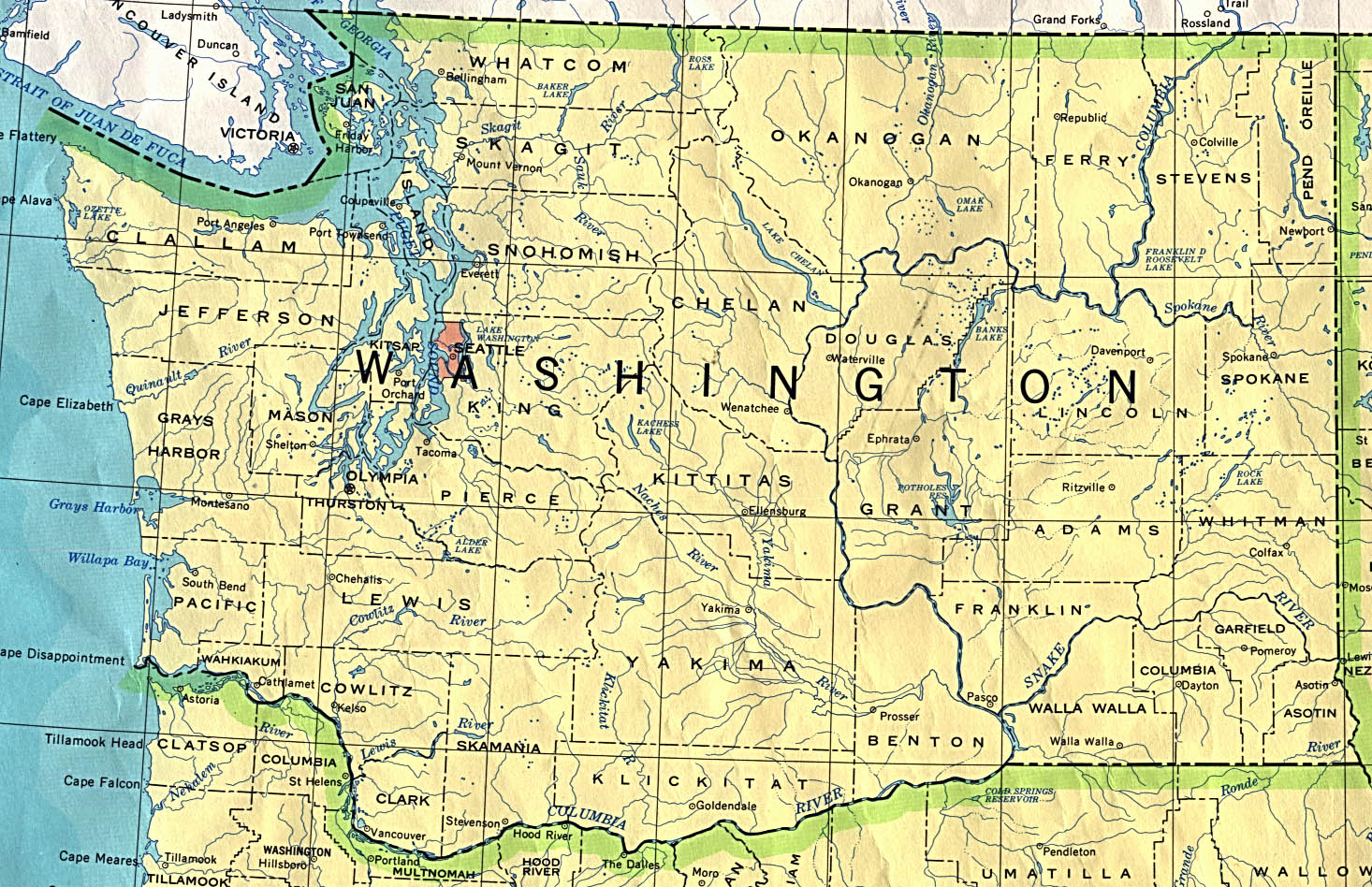Blue Highways: West Canaan, New Hampshire
Unfolding the Map
 In West Canaan, William Least Heat-Moon (LHM) remarks on the disappearing water dams and turbines that powered the factories of yesterday. Of course, I can't let an opportunity go by for talking about an alternative energy idea I had, and more. To see where you too can eat and get gas, go to the map.
In West Canaan, William Least Heat-Moon (LHM) remarks on the disappearing water dams and turbines that powered the factories of yesterday. Of course, I can't let an opportunity go by for talking about an alternative energy idea I had, and more. To see where you too can eat and get gas, go to the map.
Book Quote
"Near West Canaan, I stopped at Al's Steamed Dogs & Filling Station. A hand-painted sign: EAT HERE AND GET GAS. Al's was closed. The sky darkened, a shower doused the road and cooled things in the White Mountains. The villages seemed to seep down the slopes to settle in the valleys along streams where people of another time built multiwindowed stone and brick factories and mills. Most of the old buildings and mill dams had been done in by cheap electric power and centralized industry. But there was talk of again tapping the unused energy in the New England streams with small, computer-designed turbines."
Blue Highways: Part 8, Chapter 10
 EAT HERE & GET GAS! This is the actual sign that William Least Heat-Moon saw in West Canaan, New Hampshire. Photo by "kaszeta" and hosted at Flickr. Click on photo to go to host site.West Canaan, New Hampshire
EAT HERE & GET GAS! This is the actual sign that William Least Heat-Moon saw in West Canaan, New Hampshire. Photo by "kaszeta" and hosted at Flickr. Click on photo to go to host site.West Canaan, New Hampshire
I thought I had a great idea once. I believe that I was driving somewhere out in a very rural area; perhaps it was Texas sometime in the 90s when I lived there. I noticed that there were a lot of telephone and utility poles out there on these vast, windy plains. That in itself didn't catch me, until I also noticed all the farms and homesteads that had windmills on their property.
Some of the windmills were really, really old. You've probably seen them. They are the wooden or galvanized many-rotored windmills that were used primarily for pumping water. Many of them came from a kit, ordered at one time from a Sears catalogue. The really old ones were made from wood, but a number of them that I saw were often Aermotor metal windmills. In doing some background for this post, I began to understand that there was fierce competition in the windmill industry until eventually, Aermotor became the only producer of windmills in America with a design that so combined efficiency and effectiveness with price that it has basically remained unchanged since its first unveiling in 1888.
Basically, I saw all these windmills on properties throughout rural areas. I saw the vast windy plains. I saw telephone poles along roadsides, train tracks and other places perhaps serving their function of holding wires but nothing else. My mind then thought about all the advances made in technology, on one hand, and the continual problem we were having in breaking ourselves of fossil fuel consumption. While it is imperative that we develop alternative energies, fossil fuels (and their pollution and climate changing effects) are just too cheap. But, why couldn't someone do something that might be cheap on a small scale? I thought of the idea of parallel computing, in which each computer in an array gets a piece of a task rather than giving the whole task to one computer. Why couldn't we do that with energy, I wondered?
So, my brilliant and innovative idea was this - take all the utility poles in vast, windswept and unpopulated areas, and put a small windmill on each. These windmills would generate a little power, not much, but with the millions of telephone and utility poles out there, I speculated, each little bit of power fed into the grid, magnified by millions, might create a significant source of energy. Wind is variable, but even when some areas are not windy, other areas would be, thus creating a continual source of energy. All it would take is a small windmill on each pole and a way of feeding it into the grid. At that I got stuck, because I'm not an electrical engineer.
After checking The Google, I have discovered that I'm not the only person to have such an idea. There are a lot of people who have speculated that use could be made of the existing utility poles and telephone poles to create wind power. Here's one discussion, and another, and still a third. And there seems to be just as many people out there that are not optimistic about the idea. There are questions about mechanical feasibility, questions about windmill size and height needed, questions about who owns the utility poles and if those owners would allow these motors to be installed. But, I still think my idea could be done. The term for them, evidently, is micro-windmills. If one day you see them, remember the idea was mine first!
Why am I tilting at windmills, in a manner of speaking? I'm following up on LHM's statement about cheap energy and industrialization leading to the decline of use of factory mill dams. In the days before widespread power and cheap access to sources of combustible fuels, the engines of industry were all natural and, for the most part, clean. Dams and water spilling over and through them provided the power needed to turn equipment. Water wheels, pushed around and around by constant stream current, converted water energy into mechanical energy.
It wasn't until coal came into widespread use as a fuel whose combustion turned water into steam that could power new and more efficient machinery for production did the water wheel become quaint in its obsolescence. And in some ways, we have been paying for our industry ever since. From the environmental in the form of air and water pollution and climate change, to the social in the form of increased expectation of productivity and work polluting our calendars, we've turned our industry into expectations, and those expectations will make it difficult to go back to a simpler time when the power supply was either ourselves, or the simple things that wind and water could give us.
Yet, I'm afraid that is what we might have to do. Fossil fuels are finite, and are damaging the earth as currently used. At some point, the supply of fossil fuels will begin to decrease. The potential for active solar energy is clearly abundant, but we've yet to harness it in an manner effective for running industry. We've dammed pretty much every formerly wild river with hydroelectric potential to wring as much power out of them as possible. Some speculate that tidal action or ocean currents will be able to supply a significant source of hydroelectricity, but those innovations are still dreams. Wind energy is being utilized efficiently in places, but so far involves a significant investment in large wind turbines and land in wind corridors. There are other even more radical ideas out there, such as clean fusion energy, but they are still unreachable.
So why can't we just put a few million micro-windmills on telephone and utility poles to help solve our energy and pollution problems? I've yet to see a definitive answer that we absolutely cannot. It seems to me that it requires a will, not a fallback on the old excuse that petroleum is cheap and wind too expensive. As I write this, scientists around the world are trumpeting the seeming discovery of the Higgs boson, the particle which will allow us to explain all matter in the universe. A huge amount of effort and energy, as well as many billions of dollars, was put into discovering the Higgs boson. Why can't we put the same amount of, excuse the term, energy into exploring a radical, but possibly beneficial, way of powering our future?
But, I guess I'm just a dreamer. Now if we could only convert the gas we get from eating bad road food to useful energy, we'd be getting somewhere.
Musical Interlude
A couple of windmills songs. First up - Toad the Wet Sprocket with their song Windmills.
Second, Sting sings Windmills of Your Mind. I almost put the Dusty Springfield version on this post, but decided I liked how Sting does it better.
If you want to know more about West Canaan or Canaan
Old newspaper article about a train wreck in West Canaan
Town of Canaan
Wikipedia: Canaan
Next up: Lake Winnipesaukee, New Hampshire




 Thursday, July 5, 2012 at 4:31PM
Thursday, July 5, 2012 at 4:31PM

